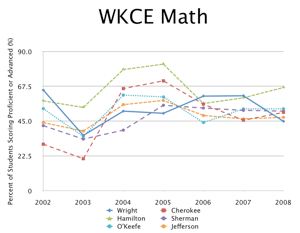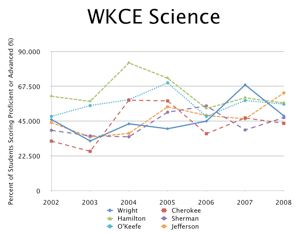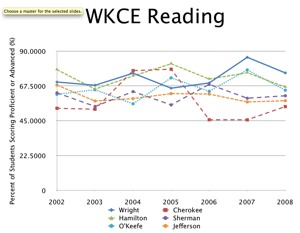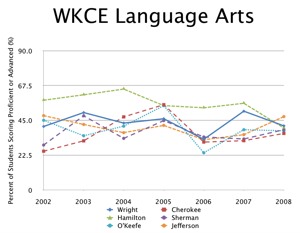whitehouse.gov:
Q Secretary Duncan, can you articulate why it’s important to link student achievement data with teacher performance, and also why it’s important to lift these caps on the charter schools?
SECRETARY DUNCAN: I’ll take one at a time. On the first one — it’s amazing, I always use the California example because California is a big state — California has 300,000 teachers — 300,000 teachers. The top 10 percent, the top 30,000 teachers in California, would be world-class, would be among the best teachers in the world. The bottom 10 percent in California, the bottom 30,000, probably need to find another line of work, another profession. And nobody can tell you of those 300,000 teachers who’s in what category. There’s no recognition.
And so what I fundamentally believe is that great teaching matters and we need to be able to identify those teachers who routinely are making an extraordinary difference in students’ lives. And to say that teaching has no impact on student performance, on student achievement, just absolutely makes no sense to me. It absolutely degrades the profession.
So the counterargument — so right now as a country basically zero percent of student achievement relates to teacher evaluation. I think that’s a problem. I also think 100 percent — if all you do is look at a test score to evaluate a teacher, I think that’s a problem. So zero is a problem; 100 is a problem. As a country, we’re here, we’re trying to move to a middle point where you would evaluate teachers on multiple measures — that’s really important — not just on a single test score, but, yes, student achievement would be a part of what you look at in evaluating a teacher.
And so whether it’s an individual teacher, whether it’s a school, whether it’s a school district, whether it’s a state, the whole thing as a country we need to do is we need to accelerate the rate of change. We have to get better faster. And there are teachers every single year — just to give you an illustration — there are teachers every single year where the average child in their class is gaining two years of growth — two years of growth per year of instruction. That is herculean work. Those teachers are the unsung heroes in our society. And nobody can tell you who those teachers are.
There are some schools that do that, not just one miraculous teacher or one miraculous student. There are schools that year after year produce students that are showing extraordinary gains. Shouldn’t we know that? Isn’t that something valuable? Shouldn’t we be learning from them?
And the flip side of it, if you have teachers or schools where students are falling further and further behind each year, I think we need to know that as well. And so we just want to have an open, honest conversation, but at the end of the day, teachers should never be evaluated on a single test score. I want to be absolutely clear there should always be multiple measures. But student achievement has to be a piece of what teachers are evaluated on.
And there’s a recent study that came out, The New Teacher Project, that talked about this Widget Effect where 99 percent of teachers were rated as superior. It’s not reality.
On your second point, on charter caps, I’ve been really clear I’m not a fan of charter schools, I’m a fan of good charter schools. And what we need in this country is just more good schools. We need more good elementary, more good middle, more good high schools. No second grader knows whether they’re going to a charter school, or a gifted school, or traditional school, or magnet school. They know, does my teacher care about me? Am I safe? Is there high expectations? Does the principal know who I am?
We need more good schools. And where you have — where you have good charters, we need to replicate them and to learn from them and to grow. Where you have bad charters, we need to close them down and hold them accountable. And so this is not let a thousand flowers bloom, this is trying to take what is being successful and grow.
And what I would say is if something is working, if you reduce — we talked about the graduation rate, if you’re doing something to reduce the dropout rate and increase the graduation rate, would you put a cap on that strategy? Would you ever say that we’re going to cap the number of students who can take AP classes this year? We’re going to limit the number of kids who take — we’re going to limit the number of kids that graduate? We would never do that.
So if something is working, if that innovation is helping us get better, why would you put an artificial cap on it? So let’s let that innovation flourish, but at the same time actually have a high bar and hold folks accountable.
So I was a big fan of successful charter schools in Chicago when I was a superintendent there, but I also closed three charter schools for academic failure. And you need both. Good charters are a big piece of the answer. Bad charters perpetuate the status quo and we need to challenge that.
Prior to the President’s visit, I emailed a number of elected officials and education stakeholders seeking commentary on the Wright Middle School visit. One of my inquiries went to the Wisconsin Charter Schools Association. I asked for a statement on charters in Madison. They declined to make a public statement, which, perhaps is a statement in and of itself.






